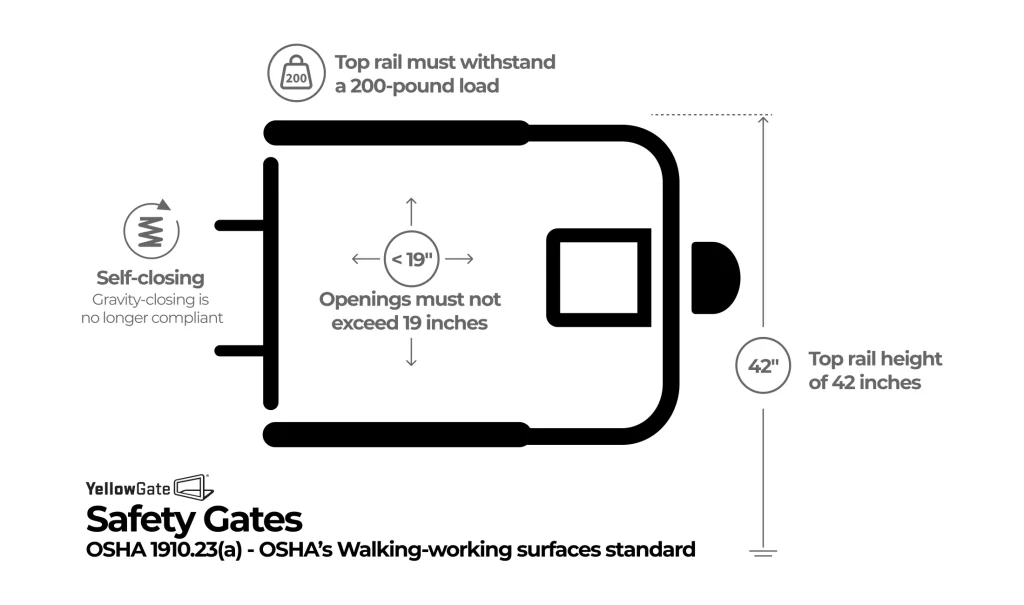
OSHA’s revised walking-working surfaces standard, updated in 2017, has introduced significant changes affecting the use of industrial safety gates. This update aims to enhance workplace safety by preventing falls and related injuries. With fall protection violations remaining a top concern for OSHA, it is essential for businesses to comply with these new regulations.
The revised standard specifies detailed requirements for safety gates, ensuring enhanced protection around vulnerable openings.
Key highlights from the new OSHA regulations include:
- Self-Closing Mechanism: Safety gates must be self-closing, sliding, or swinging away from the opening.
- Height Specifications: Gates must have a top rail height of 42 inches, plus or minus 3 inches, and a mid-rail or equivalent intermediate member.
- Load Capacity: The top rail must withstand a 200-pound load, and the mid-rail must support a 150-pound load.
- Opening Size: Gate openings must not exceed 19 inches in any dimension.
Non-compliance
For businesses currently using chains, single-bar, or drop-bar style gates, these configurations are now non-compliant. Rusted or non-functional gates must be repaired or replaced. Gravity-closing gates and those held open with bungee cords are no longer acceptable.
Steps to Compliance with YellowGate
YellowGate offers a versatile solution to meet the new OSHA standards. Our industrial safety gates are designed to provide maximum safety and flexibility in various environments:
- Adjustable Width: Easily adjusts from 21 to 37 inches to fit any opening.
- Universal Mounting: Simplifies installation with no additional parts needed.
- Durable Construction: Built from powder-coated, heavy gauge aluminum ensures long-term safety indoors and outdoors,
- Maintenance-Free Closure: Designed for durability and long service life to provide extended and reliable self-closing functionality.
Evaluate and Upgrade Your Safety Gates
Assess your current fall protection systems to ensure compliance with the new OSHA standards. Here are some steps to guide your evaluation:
- Inspect Existing Gates: Check all safety gates for compliance with the new height, load, and closing requirements.
- Replace Non-Compliant Gates: Remove any chains, bars, or gates that do not meet the new standards. Install self-closing gates that adhere to the specified criteria.
- Regular Maintenance: Ensure all gates are functional and in good condition. Schedule regular inspections and maintenance to prevent issues.
YellowGate makes compliance easy with gates that are in stock and ready to ship. Our products provide a straightforward solution to meet OSHA requirements, offering peace of mind and enhanced safety for your team.
Addendum: OSHA’s Final Rule on Walking-Working Surfaces and Fall Protection Standards
Source: OSHA
OSHA has issued a final rule on Walking-Working Surfaces and Personal Fall Protection Systems to enhance worker safety in general industry. Falls from heights and on the same level are among the leading causes of serious work-related injuries and deaths. This new rule updates and clarifies standards, incorporating advances in technology, industry best practices, and national consensus standards, while adding training and inspection requirements.
Key Highlights:
- Scope: The rule affects a wide range of workers, including painters and warehouse workers, but does not change construction or agricultural standards.
- Updates: It updates general industry standards addressing slip, trip, and fall hazards (subpart D) and adds requirements for personal fall protection systems (subpart I).
- Impact: OSHA estimates these changes will prevent 29 fatalities and 5,842 lost-workday injuries annually.
Benefits to Employers:
- Flexibility: Employers now have greater flexibility in choosing fall protection systems. The rule allows employers to select from various accepted fall protection systems rather than mandating guardrails as the primary method.
- Alignment with Construction Standards: The rule aligns fall protection requirements for general industry with those for construction, easing compliance for employers engaged in both types of activities. For instance, the outdated general industry scaffold standards are replaced with OSHA’s construction scaffold standards.
Implementation Timeline:
- January 17, 2017: Most of the rule became effective.
- May 17, 2017: Workers must be trained on fall hazards and equipment covered by the rule.
- November 20, 2017: Permanent anchorages for rope descent systems must be inspected and certified.
- November 19, 2018: Personal fall arrest or ladder safety systems must be installed on new fixed ladders over 24 feet and on replacement ladders/ladder sections.
- November 19, 2018: Existing fixed ladders over 24 feet must be equipped with a cage, well, personal fall arrest system, or ladder safety system.
- November 18, 2036: Cages and wells used as fall protection must be replaced with ladder safety or personal fall arrest systems on all fixed ladders over 24 feet.
This comprehensive update aims to significantly improve workplace safety by reducing the risk of falls and related injuries. For more information, visit the OSHA website.
